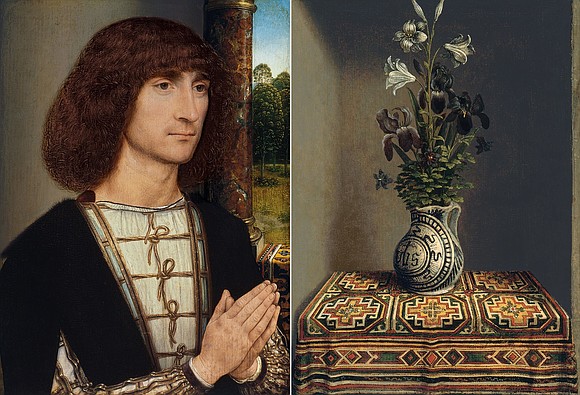Many intimate Renaissance portraits hidden behind covers — new exhibition explores why
Jacqui Palumbo, CNN | 4/5/2024, 11:29 a.m.
Half a millennium ago, the Protestant rebel priest Martin Luther sent out a number of small paintings as a marital announcement with political implications. He’d commissioned German painter Lucas Cranach the Elder to commemorate his controversial union with the nun Katharina von Bora in 1525 through complementary round portraits concealed in wooden boxes. Before long, their allies had received the secretive gift that boldly rejected Catholicism’s rules around clerical celibacy.
If it had not been for his death weeks prior, one of the recipients might have been one of Luther’s greatest defenders, the German nobleman Friedrich the Wise of Saxony, who had earlier that year commissioned his own covert portraits — for more private, lovestruck reasons. A pair of carved images concealed in walnut canisters reveal his own visage and that of his mistress, Anna Rasper, who bore him four children but was a commoner. Ornate carving on the covers — a centaur on Friedrich’s and a siren for Anna’s — evoked ideas of virility, fertility and desire.
Today, we think of Renaissance portraiture as paintings on canvas or church walls, viewed openly. But an exhibition at the Metropolitan Museum of Art in New York, “Hidden Faces: Covered Portraits of the Renaissance,” reveals how many works of art from the period were deliberately covered by painted panels or shutters, or contained additional compositions on their reverse side. As objects, they were meant to be handled, opened and flipped over as needed.
“These multisided and covered portraits have never been the subject of an exhibition before,” said the show’s curator, Alison Manges Nogueira, in a video call with CNN. “(We want) to give visitors a sense of these works as three-dimensional objects. It’s a new way of looking at this material — even to people in the field. A lot of (it) is new, because the reverses or covers of many of these portraits often are not well published.”
Researchers now know, from artists’ inventories in England, Germany, Italy, the Netherlands and Spain that this trend persisted for centuries, according to the exhibition. Many works that we see today might no longer be complete: Portraits and their covers — the latter which often depicted scenes or symbols meant to offer insights into the sitters’ characters — are often separated today, and exhibited, sold or acquired as standalone works.
“It’s similar to altarpieces where the (panels) get divided up over time, sometimes to sell them for a greater price… not only have portraits been separated from the covers, but often the backs of paintings get cut down or thinned, so that the reverse imagery is eradicated,” Nogueira explained. “The reverse of an image may have a coat of arms, and that’s considered secondary today, like the B-side, and so it’s often ignored.”
Enhancing the experience
Covering portraits heightened the viewer’s experience of engaging with them, whether romantic or political in nature (though there were practical reasons, too, such as protecting them in transit, as many were gifts). The practice also follows a “long tradition” of obscuring sacred imagery, Nogueira said added, to “enhance the divine nature of an object.”
In “Hidden Faces,” the museum reunites several works and shows theoretical companions for others.
The exhibition includes works by Albrecht Dürer, Titian and Hans Holbein. One piece is a circular cover painting by Titian, which features Cupid on the back of a lion and once concealed the (now lost) artist’s portrait of a Venetian noblewoman. Another painting, a portrait of a man by the 15th-century painter Jacometto, features on its reverse side a delicately rendered male deer in a chained collar — a symbol of fidelity. Alongside its companion portrait, of a woman in a white headscarf, the painting was likely fitted in a closed portrait box featuring scenes and symbols of love, devotion and grief — although the relationship between the two people is unclear, the context hints at a romantic connection.
There were plenty of reasons these formats were appealing to artists — they offered more space to allude to their subjects’ virtues or inner lives, or experiment with new motifs. (Nogueira points to the back of a late 15th-century portrait by Hans Memling in the exhibition that features an “astounding, highly naturalistic” botanical still life — a tradition that wouldn’t be popularized until the following century.)
By the 16th and 17th centuries, concealed portraits had became popular in more portable forms too, including in accessories like lockets, watches and false coins, as the exhibition charts. Erotic images, too, benefitted from clandestine curtains and flaps in bound books.
Opaque wooden or canvas covers began to fall out of favor toward the 17th century, possibly as glass barriers rose in popularity as another means of protection (if not disguise), Nogueira noted. But the centuries-long tradition has left an aspect of the Renaissance ripe for more study.
“We know that, during the Renaissance, a lot of imagery was intended to be enigmatic — it was intended to be interpreted in many ways and to kind of spark discussion,” Nogueira said. “And so if we find some of it confusing today, it’s not just because we’re centuries removed — it was intended to be that way.”
“There is something very timeless about trying to solve a puzzle, or interpret an image that is unclear, and there is a lot of imagery in the exhibition that defies explanation,” she added. “It’s very playful.”





